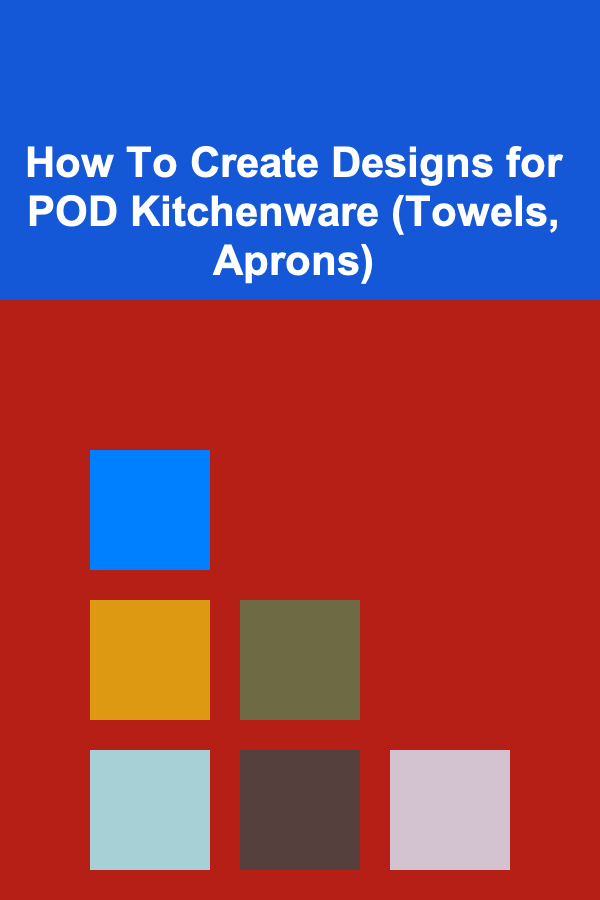
How To Create Designs for POD Kitchenware (Towels, Aprons)
ebook include PDF & Audio bundle (Micro Guide)
$12.99$8.99
Limited Time Offer! Order within the next:

Print-on-demand (POD) has revolutionized the world of e-commerce by providing an opportunity for creators to design and sell their own products without worrying about inventory or upfront costs. One of the most popular categories in POD is kitchenware, which includes towels, aprons, and other accessories. These items offer a practical use combined with a creative design, making them an ideal choice for individuals looking to add personality to their kitchen or gift something unique to others.
In this article, we will explore the process of creating designs for POD kitchenware like towels and aprons. From understanding the products and target audience to the actual design and technical aspects, we will cover the key steps to help you create captivating and marketable designs for these popular kitchen accessories.
Understanding the POD Kitchenware Market
Before diving into the design process, it's important to understand the market you're entering. POD kitchenware products, especially towels and aprons, are used daily and come in various styles, sizes, and designs. The key to creating successful designs is to understand the product's purpose and how design can add value to it. Here's a deeper dive into the target audience and trends:
1.1 Target Audience
Your target audience will largely influence the type of designs you create. Some of the main consumer groups for kitchenware include:
- Home Cooks and Food Enthusiasts: People who spend a lot of time cooking at home will appreciate functional, stylish kitchenware. Designs for this group can range from humorous and quirky to elegant and sophisticated.
- Gift Shoppers: Kitchenware items are common gift choices for housewarming parties, weddings, birthdays, and holidays. Designs in this category should have universal appeal, offering something that fits various tastes and occasions.
- Parents and Families: Aprons and towels are often used by parents who want fun, functional designs for their children's kitchen play or for family cooking activities. These designs could be playful, colorful, and designed to engage young children.
- Minimalists and Interior Designers: For people interested in home décor, especially those who appreciate minimalism or a cohesive kitchen aesthetic, you can create sleek, modern, or even monochrome designs that match current kitchen trends.
1.2 Trends in Kitchenware Design
The kitchenware market is influenced by both functionality and visual appeal. The following trends can inspire your designs:
- Bold Typography: Many customers enjoy kitchen towels or aprons with catchy phrases or motivational quotes. Bold, easy-to-read typography works well on these products.
- Illustrations and Graphics: Simple, hand-drawn illustrations of fruits, vegetables, herbs, and utensils are popular. These designs can be playful, elegant, or rustic, depending on your audience.
- Retro and Vintage Styles: Vintage designs, especially those inspired by old-school diner aesthetics, can evoke a sense of nostalgia and add a personal touch to any kitchen.
- Eco-Friendly and Sustainable Designs: As consumers become more eco-conscious, they are seeking products that align with their values. Designs that emphasize sustainability, nature, and organic elements can attract this audience.
- Personalization: Customizable designs for towels and aprons---such as adding names, initials, or monograms---are in high demand, particularly for gift-giving purposes.
Design Process for POD Kitchenware
Creating designs for kitchen towels and aprons requires both artistic creativity and technical know-how. Below is a step-by-step guide to the design process, starting from initial concept creation to final product readiness.
2.1 Conceptualization
The first step in any design process is conceptualization. Before creating digital artwork, it's essential to have a clear vision of the design you want to produce. This process involves:
- Identifying the Theme: What do you want your design to communicate? The theme can be anything from cooking, humor, and family-oriented designs to seasonal themes or pop culture references. Consider using design software or sketching to brainstorm.
- Researching Trends and Competitors: Take the time to look at what other creators are offering in the POD kitchenware space. Research social media platforms, marketplaces like Etsy, and design blogs to understand what's trending and where there's room for innovation.
- Defining the Style: Will your design be minimalist, bold, playful, or elegant? Define your style clearly to ensure consistency throughout your designs.
2.2 Sketching and Brainstorming
Once you have a theme and style in mind, sketch out your ideas. You don't need to be a professional artist---rough sketches will help you visualize your design. Consider the following:
- Illustration or Typography: If you're focusing on typography, explore different fonts and layout styles. If your design is more illustrative, decide on the graphics, shapes, and patterns.
- Balance and Composition: Keep in mind the space where the design will be placed. For towels and aprons, the design should be balanced and center-focused or distributed in a way that makes the product visually appealing.
- Color Schemes: The colors you choose will affect the mood of the design. Bright, bold colors are energetic and fun, while muted, neutral colors can add sophistication. Make sure your color palette aligns with the target audience and product style.
2.3 Digitizing the Design
After you've settled on your sketches, it's time to digitize the design. This is where design software such as Adobe Illustrator, CorelDRAW, or Procreate comes into play.
- Vectorizing Your Artwork: For optimal print quality, create your designs in vector format (using tools like Illustrator). Vector files are scalable without losing resolution, making them ideal for print-on-demand products.
- Adding Colors and Details: Add your chosen color scheme to the design. Experiment with different gradients, textures, and effects to make the design pop.
- Ensure Readability: If your design includes text, make sure the font is legible. Choose a size and spacing that will be readable from a distance, especially for towels and aprons that will be used in various lighting and angles.
- Incorporating Seamless Patterns: For products like towels, you may want to create seamless patterns that can be repeated across the fabric without disrupting the design's flow.
2.4 Preparing the Design for Printing
Once your design is digitized and ready, it's time to prepare it for printing. Each print-on-demand provider has different requirements for artwork file submissions, so make sure you follow these instructions carefully.
- File Format: The most commonly accepted formats for POD platforms are PNG, JPEG, and sometimes vector files like SVG or EPS. Ensure your files are high resolution (300 DPI) to guarantee the print quality.
- Mockups and Visualization: Before submitting the design, create mockups to visualize how the design will look on towels or aprons. This step helps you assess whether the design needs any adjustments to fit the product's dimensions.
- Product Dimensions: Make sure the design fits the specified area for the product, whether it's the front of the apron, the corner of the towel, or across the entire surface. Respect the boundaries set by your POD provider.
2.5 Uploading and Launching
After preparing your design files, it's time to upload them to your chosen print-on-demand platform. Popular POD platforms for kitchenware include Printful, Redbubble, and Society6. Here's how to ensure a successful upload:
- Choose the Right Product Type: Make sure you select the correct product (e.g., kitchen towels or aprons) to upload your design to.
- Check the Design Preview: Most platforms provide a preview feature that allows you to see how your design will look on the product. Double-check to ensure your design looks well-proportioned and appealing.
- Add Descriptions and Tags: To maximize visibility, include an engaging product description and relevant tags. Highlight the key features and target audience of your design.
- Set Your Pricing: Establish a competitive pricing strategy based on production costs, market trends, and the value your design brings to the consumer.
Marketing Your Designs
Creating amazing designs is just one part of the process; promoting your designs is equally important. Here are some strategies to effectively market your POD kitchenware products:
3.1 Social Media Marketing
Social media is one of the most powerful tools for promoting POD products. Use platforms like Instagram, Pinterest, and Facebook to showcase your designs.
- Create Engaging Content: Post lifestyle photos, behind-the-scenes content, and customer reviews to engage potential buyers.
- Hashtags and Trends: Utilize trending hashtags related to kitchen décor, cooking, and gift-giving to increase visibility.
- Influencer Collaborations: Partnering with food bloggers or influencers in the home décor niche can help get your products in front of a larger audience.
3.2 SEO for E-Commerce
If you're selling on platforms like Etsy, make sure to optimize your product listings for search engines. Use relevant keywords in your titles, descriptions, and tags to increase discoverability.
3.3 Email Marketing
Build an email list of potential customers and send them updates on new product releases, promotions, and special offers. Personalized emails can boost engagement and increase sales.
Conclusion
Creating designs for POD kitchenware like towels and aprons is a great way to tap into a popular and growing market. By understanding your target audience, following a clear design process, and effectively marketing your products, you can build a successful POD business. Remember that creativity, attention to detail, and understanding current trends are key to creating designs that stand out in a competitive market. Happy designing!

Essential Money-Saving Tips for College Students on a Tight Budget
Read More
How to Deal with Rent Control and Local Regulations for Rental Properties
Read More
How to Use Seasonal Ingredients for Flavorful Meal Prep
Read More
Philosophy of Science Fiction: Exploring the Themes and Significance of Science Fiction
Read More
How to Learn Basic Rock Climbing Techniques
Read More
How to Vote While Living Abroad: A Comprehensive Guide
Read MoreOther Products

Essential Money-Saving Tips for College Students on a Tight Budget
Read More
How to Deal with Rent Control and Local Regulations for Rental Properties
Read More
How to Use Seasonal Ingredients for Flavorful Meal Prep
Read More
Philosophy of Science Fiction: Exploring the Themes and Significance of Science Fiction
Read More
How to Learn Basic Rock Climbing Techniques
Read More